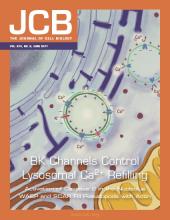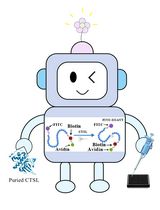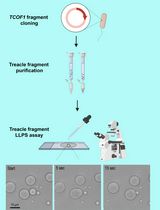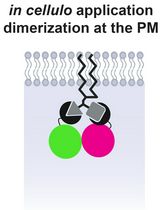- EN - English
- CN - 中文
Cell-free Generation of COPII-coated Procollagen I Carriers
COPII包被的前胶原I载体的无细胞生成
发布: 2017年11月20日第7卷第22期 DOI: 10.21769/BioProtoc.2450 浏览次数: 8323
评审: Gal HaimovichAnonymous reviewer(s)
Abstract
The aim of this protocol is to generate COPII-coated procollagen I (PC1) carriers in a cell-free reaction. The COPII-coated PC1 carriers were reconstituted from donor membrane, cytosol, purified recombinant COPII proteins, and nucleotides. This protocol describes the preparation of donor membrane and cytosol, the assembly of the reaction, and the isolation and detection of reconstituted COPII-coated carriers. This cell-free reaction can be used to test conditions that stimulate or suppress the packaging of PC1 into COPII-coated carriers.
Keywords: COPII (COPII)Background
The coat protein complex II (COPII) plays an essential role in transporting secretory cargos from the endoplasmic reticulum (ER) en route to the Golgi apparatus. The genes required for cargo traffic from the ER were discovered in genetic studies in yeast and the precise roles of the protein products of the genes required for vesicle budding were elucidated with the aid of a cell-free vesicle budding reaction supplemented with purified components (Novick et al., 1981; Kaiser et al., 1990; Barlowe et al., 1994). A similar reaction was developed to detect the role of COPII in cargo traffic from the ER in cultured mammalian cells (Kim et al., 2005). Mammalian COPII-coated vesicles are approximately 80-100 nm in diameter, which is seemingly too small to accommodate large secretory cargos such as the rigid 300 nm procollagen I (PC1) triple helical rod. Despite the potential size discrepancy, COPII is essential for the secretion of large cargos including PC1 (Boyadjiev et al., 2006). Recently, we reported the existence of bona fide large COPII-coated PC1 carriers, exceeding 300 nm in diameter, in cells evaluated by stochastic optical reconstruction microscopy (STORM), correlated light electron microscopy (CLEM) and live-cell imaging (Gorur et al., 2017). Cell-free COPII budding reactions that successfully reconstituted small COPII vesicles did not allow the detection of large COPII-coated PC1 carriers (Fromme and Schekman, 2005). Therefore, we devised an alternative vesicle budding protocol to allow the detection of PC1 packaged into large COPII vesicles as well as the characterization of both small and large COPII-coated vesicles. Using this new protocol, we showed that the capture of PC1 into large COPII vesicles requires COPII proteins and the GTPase activity of the COPII subunit SAR1 (Gorur et al., 2017).
Materials and Reagents
- Falcon® 150 mm TC-treated cell culture dish (Corning, Falcon®, catalog number: 353025 ) or equivalent
- BioExpress GeneMate 50 ml centrifuge tubes (BioExpress, Greiner Bio One, catalog number: C-3394-4 ) or equivalent
- BioExpress GeneMate racked pipet tips, low retention, 200 μl (BioExpress, catalog number: P-1234-200)
Manufacturer: Biotix, catalog number: P-1234-200CS . - BioExpress GeneMate racked pipet tips, low retention, 1,000 μl (BioExpress, catalog number: P-1234-1000)
Manufacturer: Biotix, catalog number: P-1234-1000CS . - BioExpress GeneMate 15 ml centrifuge tubes (BioExpress, Greiner Bio One, catalog number: C-3394-2 ) or equivalent
- Falcon® 100 mm TC-treated cell culture dish (Corning, Falcon®, catalog number: 353003 ) or equivalent
- Amicon® Ultra-15 ml centrifugal filter unit with Ultracel-3K membrane (Merck, catalog number: UFC900324 )
- Amicon® Ultra-0.5 ml centrifugal filter unit with Ultracel-3K membrane (Merck, catalog number: UFC500324 )
- Oxygen® 1.5 ml MAXYMmum recoveryTM microcentrifuge tube (low retention) (Corning, Axygen®, catalog number: MCT-150-L-C )
- Microscope slides (Fisher Scientific, catalog number: 12-550-343 ) or equivalent
- Microscope cover glass (Fisher Scientific, catalog number: 12-542A ) or equivalent
- Tube, 7 x 20 mm, thickwall, polycarbonate (Beckman Coulter, catalog number: 343775 )
- Prot/Elec tips (gel loading tips) (Bio-Rad Laboratories, catalog number: 2239915 )
- Cell scraper 25 cm (SARSTEDT, catalog number: 83.1830 ) or equivalent
- Corning 1 L filter system 0.22 μm (Corning, catalog number: 431098 ) or equivalent
- Steriflip® 50 ml filter 0.22 μm (Merck, catalog number: SCGP00525 ) or equivalent
- Posi-click 1.7 ml micro-centrifuge tube (Danville Scientific, catalog number: C2170 (1001002)) or equivalent
- Microfuge tube, polypropylene, 1.5 ml (Beckman Coulter, catalog number: 357448 )
- Cuvettes (SARSTEDT, catalog number: 67.742 )
- Immobilon®-P transfer membrane PVDF 0.45 μm (Merck, catalog number: IPVH00010 )
- HT-1080 human fibrosarcoma (ATCC, catalog number: CCL-121 ) for cytosol preparation
Note: Other fast-growing cell lines that support PC1 secretion may also be used for this purpose. - IMR-90 human lung fibroblasts (Coriell Cell Repositories at the National Institute on Aging, Coriell Institute for Medical Research) (Coriell Institute, catalog number: I90-83 ) for donor membrane preparation
Note: Other cell lines that express endogenous PC1 and prolific at PC1 secretion may be used for this purpose. For this reaction, it is important to use young IMR-90 with cumulative Population Doubling Level (PDL) lower than 37.5, because aged cells secrete significantly less PC1. PDL was calculated using a standard formula: cumulative PDL = initial PDL + 3.32 [log (current cell yield) - log (cell plated)]. - Phosphate-buffered saline (PBS, pH 7.4)
- cOmpleteTM, EDTA-free, protease inhibitor cocktail tablets (Roche Diagnostics, catalog number: 05056489001 )
- Bio-beadsTM SM-2 adsorbent media (Bio-Rad Laboratories, catalog number: 1523920 )
- Bio-Rad protein assay dye reagent concentrate (Bradford) (Bio-Rad Laboratories, catalog number: 5000006 )
- Liquid nitrogen
- 0.25% trypsin-EDTA (Thermo Fisher Scientific, GibcoTM, catalog number: 25200056 )
- HyClone® trypan blue solution (GE Healthcare, HyCloneTM, catalog number: SV30084 )
- OptiPrepTM density gradient medium (Sigma-Aldrich, catalog number: D1556 )
- NovexTM WedgeWellTM 4-20% Tris-glycine gel (Thermo Fisher Scientific, InvitrogenTM, catalog number: XP04205BOX )
- Antibodies
- Rabbit anti-PC1 (LF-41) was a gift from L. Fisher (National Institute of Dental and Craniofacial Research, Bethesda, MD), and it was used at 1:5,000
- Rabbit anti ribophorin I, ERGIC53, and SEC22B were made in-house and they were used at 1:5,000
- Mouse anti HSP47 (Enzo Life Sciences, catalog number: ADI-SPA-470-D ), and it was used at 1:5,000
- Rabbit anti-PC1 (LF-41) was a gift from L. Fisher (National Institute of Dental and Craniofacial Research, Bethesda, MD), and it was used at 1:5,000
- PierceTM ECL 2 Western blotting substrate (Thermo Fisher Scientific, catalog number: 32132 )
- Bovine serum albumin (BSA) (Sigma-Aldrich, catalog number: A3294-100G )
- Life Science Seradigm premium grade fetal bovine serum (FBS) (VWR, catalog number: 1500-500 )
- DMEM, GlutaMAXTM (Thermo Fisher Scientific, GibcoTM, catalog number: 10566016 )
- HEPES (Sigma-Aldrich, catalog number: RDD002-1KG )
- Potassium hydroxide (KOH)
- D-Sorbitol (Sigma-Aldrich, catalog number: S1876-5KG )
- Potassium acetate (KoAc) (Fisher Scientific, catalog number: BP364-500 )
- Magnesium acetate tetrahydrate (MgoAc) (Sigma-Aldrich, catalog number: M0631-500G )
- Sodium dodecyl sulfate (SDS) (Avantor Performance Materials, J.T.Baker®, catalog number: 4095-02 )
- Glycerol (AMRESCO, catalog number: M152-4L )
- Bromophenol blue (Bio-Rad Laboratories, catalog number: 1610404 )
- Glycine (Fisher Scientific, catalog number: BP381-5 )
- 2-Mercaptoethanol (βME) (AMRESCO, catalog number: M131-100ML )
- Sodium chloride (NaCl) (Fisher Scientific, catalog number: S271-3 )
- Tris base (Fisher Scientific, catalog number: BP152-5 )
- Triton® X-100 (Sigma-Aldrich, catalog number: X100-500ML )
- TWEEN® 20 (Sigma-Aldrich, catalog number: P7949-500ML )
- Tris-buffered saline (TBS, pH 7.6)
- Digitonin (Sigma-Aldrich, catalog number: D141-500MG )
- Dimethyl sulfoxide (DSMO) (Sigma-Aldrich, catalog number: D8418-100ML )
- Trypsin inhibitor from glycine max (soybean) (Sigma-Aldrich, catalog number: T9003 )
- Lithium chloride (LiCl) (Sigma-Aldrich, catalog number: 203637 )
- Creatine phosphate (Sigma-Aldrich, catalog number: 2380-25GM )
- Creatine kinase (Roche Diagnostics, catalog number: 10127566001 )
- Adenosine 5’-triphosphate (ATP) (GE Healthcare, catalog number: 27-1006-01 )
- GTP 100 mM Li Salt (Sigma-Aldrich, Roche Diagnostics, catalog number: 11140957001 )
- Methanol (Fisher Scientific, catalog number: A452-4 )
- Mammalian cell culture medium (see Recipes)
- Buffer solutions (see Recipes)
- B88
- B88-0
- Sample buffer (5x)
- Buffer C
- Sample buffer C (1x)
- Transfer buffer
- HK buffer
- TBST
- B88
- Stock solutions (see Recipes)
- 1 M HEPES pH 7.2
- 10% SDS
- Digitonin stock
- Trypsin inhibitor stock
- 0.5 M LiCl
- ATP regeneration system (ATP r.s.)
- GTP
- 1 M HEPES pH 7.2
Equipment
- SorvallTM ST16R centrifuge, TX-200 Swinging Bucket Rotor, 400 ml Round Buckets, 4 x 50 ml, 9 x 15 ml conical adapters (Thermo Fisher Scientific, model: SorvallTM ST 16R , catalog number: 75818382) or equivalent
- TLA-55 ultracentrifuge rotor (Beckman Coulter, model: TLA-55 , catalog number: 366725)
- Centrifuge 5430R, refrigerated with fixed angle rotor FA-45-30-11 (Eppendorf, model: 5430 R , catalog number: 5428000015)
- Light microscope with a 16x or 25x objective (any simple or compound light microscope is fine)
- S-24-11-AT swinging bucket rotor (Eppendorf, catalog number: 5409715003 )
- Spectronic Genesys 5 spectrophotometer (Spectronic Instruments) or equivalent
- Table top ultracentrifuge, we used Optima MAX-XP, Optima TL, and Optima TL-100 for this experiment (Beckman Coulter, models: OptimatTM MAX-XP , OptimaTM TL , OptimaTM TL-100 )
- Microman® positive-displacement pipet M250 (Gilson, catalog number: F148505 )
- Microman® capillary pistons for M250 (Gilson, catalog number: F148114 )
- TLS-55 swinging bucket ultracentrifuge rotor (Beckman Coulter, model: TLS-55 , catalog number: 346936)
- TLS-55 adapter, Delrin, for 7 x 20 mm tubes (Beckman Coulter, catalog number: 358615 )
- Micro tube mixer MT-360 (TOMY SEIKO, model: MT-360 )
- BioExpress GeneMate GyroMixer XL (BioExpress, GeneMate, catalog number: R-3200-1XL ) or equivalent platform rotator
- ChemiDocTM MP Imaging System (Bio-Rad Laboratories, model: ChemiDocTM MP )
- Small beaker
Software
- ImageLab software v4.0
- ImageJ
Procedure
文章信息
版权信息
© 2017 The Authors; exclusive licensee Bio-protocol LLC.
如何引用
Readers should cite both the Bio-protocol article and the original research article where this protocol was used:
- Yuan, L., Baba, S., Bajaj, K. and Schekman, R. (2017). Cell-free Generation of COPII-coated Procollagen I Carriers. Bio-protocol 7(22): e2450. DOI: 10.21769/BioProtoc.2450.
- Gorur, A., Yuan, L., Kenny, S. J., Baba, S., Xu, K. and Schekman, R. (2017). COPII-coated membranes function as transport carriers of intracellular procollagen I. J Cell Biol 216(6): 1745-1759.
分类
生物化学 > 脂质 > 脂质-蛋白互作
生物化学 > 蛋白质 > 分离和纯化
您对这篇实验方法有问题吗?
在此处发布您的问题,我们将邀请本文作者来回答。同时,我们会将您的问题发布到Bio-protocol Exchange,以便寻求社区成员的帮助。
提问指南
+ 问题描述
写下详细的问题描述,包括所有有助于他人回答您问题的信息(例如实验过程、条件和相关图像等)。
Share
Bluesky
X
Copy link












